Note: If an image ever fails to appear - refresh your page, it really is there
Flags of the World War II Era
| Between Wars | Flags of the Axis Powers | Flags of the Allies |
Between World Wars
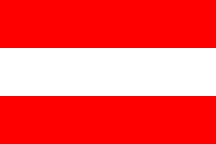
Austria after 1918
|
Flag of Austria 1918-1934
At the end of World War I the Austro-Hungarian Empire was divided back up into two separate countries again, those of Austria and Hungary respectively. The Hapsburgs were replaced by the First Republic after World War I in 1918. In 1934 Austria voted to become part of Hitler's Third Reich. |

Hungarian Soviet Republic
|
The Hungarian Soviet Republic Flag 1919
The Hungarian Soviet Republic was a Communist regime established in Hungary from March 21 until August 6, 1919, under the leadership of Béla Kun. Lasting only four months, the Soviet republic fell apart when Romanian forces invaded Budapest. The Kingdom of Hungary, actually a dictatorship under Admiral Horthy, formed after the Romanian Army pulled out of Hungary. |

Kingdom of Hungary
|
The Kingdom of Hungary Flag 1919-1944
In Hungary a dictatorship under Admiral Horthy seized power in 1919 and ruled until overthrown by the Germans. The Third Reich took over Hungary in 1944 and imposed a pro-Nazi regime.
|

USSR Flag
|
The Union of Soviet Socialist Republics Flag (USSR) 1923-1990
The Communist Party replaced the Imperial Russian flag with the Soviet flag with hammer, sickle and star, but it was not created in 1918! It was adopted in 1923.
The hammer and sickle represented the Russian peasants (the sickle) and the Russian workers (the hammer) who together formed the Soviet Russian state. The red field was said to represent the blood that was spilt by workers the world over in the fight for their emancipation, and was directly inherited from the red banner flown in the Paris Commune during the French Revolution. The single yellow star represented life and immense energy of the sun. The star was empty because it was said to contain the blood of the workers' struggle; and the five points of the star symbolized the then-known five continents where the revolution would spread. |
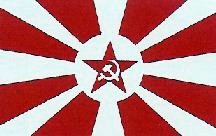
USSR Naval Ensign
|
The Union of Soviet Socialist Republics Naval Ensign 1924-1935
This naval ensign was introducted by the Communist government with the establishment of the USSR in 1924 and used by all Russian Warships until 1935. Because of its similarity to the Japanese Rising Sun Naval Ensign it was changed in 1935. |
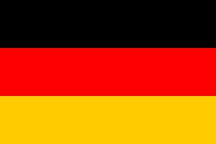
Weimar Republic
|
The Weimar Republic Flag 1919-1933
Black, red and gold in three equal horizontal stripes are the colors of the flag of the Federal Republic of Germany. The colors date to the emperors of the Middle Ages. They reappeared in the war against Napoleon when a corps of army volunteers drawn from all the German principalities adopted black uniforms with red braid and gold buttons.
Subsequently, student organizations, dedicated to the unification of Germany, used the colors on their banners. In the first attempt to create a democratic and unified Germany, leaders of the 1848 Revolution adopted the tricolor flag in the National Assembly or Frankfurt Parliament.
The flag was not actually used until 1918 when the German National Assembly of the democratic Weimar Republic adopted it officially. When Hitler came to power in 1933 he abolished the tricolor flag. In 1950, the flag was reintroduced by the German Parliament as the official symbol for the Federal Republic of Germany and is still used today.
|
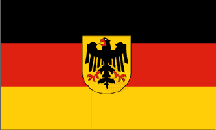
Weimar State Flag
|
The Weimar Republic State Flag 1921-1933
This design was used as the German flag by such organizations as the German postal service and other non-military official authorities and organizations, although occasionally they would also use the simple tricolor as well. The black-red-gold is historically associated with "liberal" nationalism in Germany.
This flag was also called as the Dienstflagge der übrigen Reichsbehörden zu Lande (Service flag on land). This flag was abolished on April 22, 1933, by Adolf Hitler's government. |
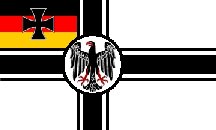
Weimar War Flag
|
The Weimar Republic War Flag 1919-1921
This was the Reichskriegsflagge adopted in 1919. It was never used, although samples were produced, because the old Imperial War Ensign of 1888 remained in use throughout this time period.
The new unused design was based on the previous imperial war ensign, replacing the eagle and the black-white-red canton with a black-red-gold canton.
( Click here to learn more about the history of the Imperial War Flag 1867-1921 )
|
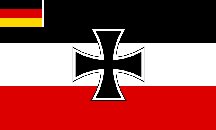
German War Flag
|
The Weimar War Flag 1922-1935
Since the leadership of the German Navy did not accept the new republican Reichskriegsflagge adopted in 1919 and refused to hoist the new version and insisted upon using the old Imperial War Flag of the German Empire, on January 1, 1922, this entirely new design replaced the War Flag of the German Empire.
It was in use between the years 1922-1935. It was replaced by the swastika type in 1935.
( Click here to learn more about the history of the Imperial War Flag 1867-1921 ) |
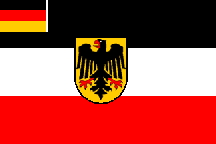
Weimar Service Flag
|
The Weimar Republic Service Flag 1921-1933
This was the flag normally used by all German Government Ships smaller than a warship at sea between 1921-1933. This flag was also know as the Dienstflagge der übrigen Reichsbehörden zur See (Service flag on sea). It's use was abolished on March 31, 1933, by Adolf Hitler's government. |
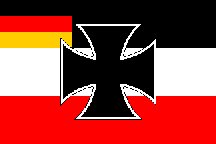
Weimar Navy Jack
|
The Weimar Republic Naval Jack 1921-1933
This jack (Gösch) was used by German Naval ships until 1933.
On warships, the jack is flown from a flag pole (jack-staff) located on the vessel's front end (bow) when at anchor or in port. |
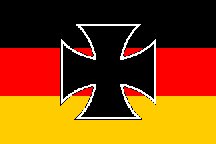
Weimar War Minister
|
The Weimar Republic War Minister's Flag 1921-1933
The was actually the second variant of the War Minister's flag and adopted in 1921. It only changed the proportion of the flag to 2:3, and made the Iron Cross "thicker". The first version of the Flagge des Reichswehrministers is very similar and not shown. |
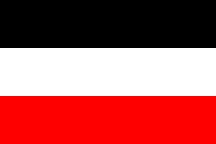
German Tricolor
|
The German National Tricolor Flag 1932-1935
The German Imperial Tricolor flag was briefly reintroduced between 1933-1935 and used jointly with the Nazi Swastika Flag, then abolished in 1935 to try and prevent it being used by reactionary groups. |
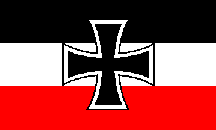
German Naval Jack
|
The German War Ensign and Naval Jack 1933-1935
This was the flag used by all German warships between 1933-1935. It was replaced by the swastika type Naval Flag in 1935
On warships, the jack is flown from a flag pole (jack-staff) located on the vessel's front end (bow) when at anchor or in port. In the case of this flag it was also used as a regular ensign, or flag to be flown while at sea. |
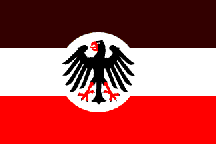
German State Flag
(For civilian use on land)
|
The German State Flag and Ensign 1933-1935
This was the German State flag and ensign used between the years 1933-1935. Although in March of 1933, the swastika flag was introduced as national flag, Paul von Hindenburg was still President of the Reich. Nothing could be done about the existing Weimar Republic Service flags without the agreement of the President. In the end it was agreed to reinstate some of the former Imperial Service flag designs in March and April of 1933.
The Wehrmacht only used this particular State Service flag design from March 14, 1933 until April 21, 1933. |
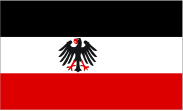
Military Service Flag
(For use at Sea)
|
The German Service Flag and Ensign 1933-1935
In March and April of 1933, a couple "new/old" Service flags (which used imperial colors) were approved: one for at sea by military ships, and one on land as substitute for the civilian Service Flag which used the Weimar colors.
This flag saw use at sea from March 31, 1933, until replaced by the swastika Service Flag in 1935. |
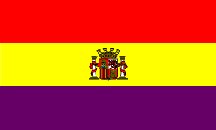
Second Spanish Republic 1931
|
The Second Spanish Republic 1931-1939
The Second Spanish Republic officially began in 1931 when King Alfonso XIII left the country following elections in which republican candidates won the majority of votes. Five years later, between 1936 and 1939 the Spanish Civil War broke out between the Nationalist (nacionales) forces of Francisco Franco and the Republican (republicanas) govermental forces. Thanks largely to military aid received from Nazi Germany Franco was victorious.
The unusual purple color stripe that replaced the lower traditional red on the Second Repubic flag was based the color used by Castilian Commoners when they fought against Charles V. This flag was flown on coastal fortresses and other military and official buildings during the repubic rule.
|
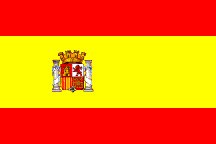
Rebel Nationalist Spain 1936
|
The Rebel Nationalist Flag 1936-1939
The Spanish Civil War (1936-1939) is largely seen as a testing ground for Fascist Italy and Nazi Germany to test their armor tactics and the effectiveness of bombing cities from the air that became the standard in the later war in Europe. The Spanish Civil War started as an attempted coup d'état by a group of Spanish Army generals against the government of the Second Spanish Republic. The resulting civil war devastated Spain and ended with the victory of the rebel forces, and the overthrow of the Republican government.
|
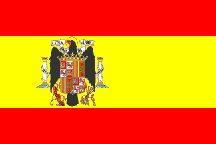
Fascist Spain 1939-1945
|
The Spanish State Flag 1939-1945
General Francisco Franco became the undisputed dictator of Spain when he defeated the Republican government in the Spanish Civil War with military help from Adolf Hitler. Franco declared an official end of hostilities on April 1, 1939, and formed what he called the "Spanish State."
When World War II started Franco kept Spain out of it, and when the Axis Powers were defeated in 1945, Franco remained in power until his death in 1975.
|
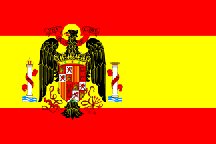
Spanish State Flag 1945-1977
|
The Spanish State Flag 1945–1977
In 1945, after the defeat of the Third Reich and their Axis allies, Franco changed the Spanish Coat-of-arms used on the flag to a new and larger design. This new version of the flag continued being used as the Spanish State Flag, even after Franco's death in 1975, until 1977.
The current modern Spanish State Flag (not shown here) uses a coat-of-arms that dates from 1981. |
| Between Wars | Flags of the Axis Powers | Flags of the Allies |
Flags of the Axis Powers
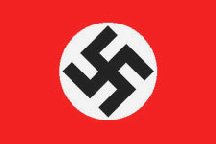
The NSDAP Party Flag
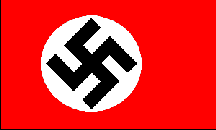
The German National Flag
(after 1935)
|
National Socialist German Workers Party (NADAP) 1920-1945
The Third Reich National Flag 1935-1945
Originally, this was the flag of the NSDAP Party, but Hitler made it the National Flag after 1935. Notice that the white circle is centered on the top flag, that would make it a NSDAP Party flag. In fact, all centered-disk versions of the flag used after 1935 were Party flags of the NSDAP.
In September of 1935, the Party flag became the national flag with one slight change concerning the position of the swastika. Henceforth, the regulations demanded the disk and swastika to be "slightly" set off the center towards the flag pole. Since the regulation did not give the offset measurement exactly, some confusion resulted. The reverse side of the national flag was the same as the obverse, i.e. both sides displayed a "right-facing" swastika until 1935.
The Merchant flag, as well as the Naval Ensign, were the same as the National flag, with an off-centered disk with swastika, both sides displayed a "right-facing" swastika. It was used jointly with the black-white-red striped flag. Eventually, the reverse side of the flag was changed to a "through and through" swastika image, although it is not absolutely clear when this change took place.
( Click here to learn more about the different versions of the swastika flag ) |
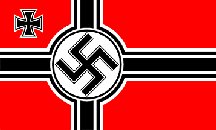
German War Ensign
|
Nazi Germany's Battle Flag 1938-1945
With the rise to power of the Nazi Party a new German battle flag was introduced. It replaced the stripes of the German Imperial flag in the canton (upper right hand corner) with a single iron cross, and turned the flag's white field (background) red, and then replaced the Prussian eagle in the center with the Swastika symbol of the Nazi party. German soldiers marched to carry out the wishes of Adolf Hitler during World War II using this flag.
|

German Merchant Flag
|
Third Reich Merchant Flag 1935-1945
This was the official merchant flag and flown by all non-warships the ships of Germany during World War II. The Merchant Flag is identical to the National Flag, with the swastika slightly off-center nearer to the hoist, after 1935.
The Germans started World War II by invading Czechoslovakia in 1938, Norway, Denmark and Poland in 1939, and France in 1940.
( Click here to learn more about the different versions of the swastika flag )
|
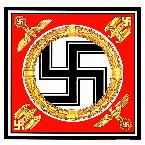
National Chancellor Banner
|
Adolf Hitler's Personal Banner 1935-1945
This was the personal standard of Adolf Hitler as "Der Fuhrer" (The Leader) and as Chancellor of Nazi Germany. It was designed to be carried in front of military formations on a pole with the standard centered on a pole during ceremonies, much the same as ancient Roman legions carried their eagles. |

Kingdom of Italy
|
The Kingdom of Italy Flag 1848-1946
There is not any agreement regarding the meaning of the colors of the Italian flag . However the most valid hypothesis is that the colors came from the colors of the uniforms of the Civic Militia of Milan. These were green and white and with some red parts added in 1796 when the Militia become the National Guard.
|
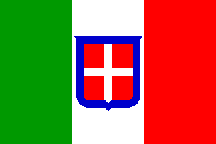
Italian Naval Ensign
|
The Italian Naval Ensign 1848-1946
In order to avoid confusion with the Mexican flag at sea, a shield was added to the center white stripe. |
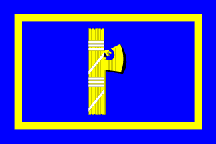
Italian Prime Minister
|
Mussolini's Personal Flag 1923-1945
As Italian head of government, Benito Mussolini displayed a distinctive personal flag. This flag was royal blue with a square golden-yellow band around the "fasces" in the center of the flag. Even though the flag was only used by Mussolini, it was officially the flag of the Prime Minister of Fascist Italy. |
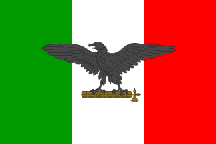
Italian Socialist Republic
|
Italian Social Republic War Flag 1943-1945
The Italian flag didn't change when Mussolini rose to power. However, in 1943 Mussolini announced the new Italian Social Republic, limited to the parts of northern Italy still under German occupation. The national flag was the plain tricolor, while the war flag added to it a black or dark silver eagle grasping a golden fasces. |

Imperial Japan
|
Imperial Japanese National Flag 1870-present
In 1938, Japan conquered Korea, and in 1939 attacked China and French Indo-China. Japan's attack on Pearl Harbor in 1941 started World War II in the Pacific . |
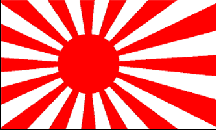
Japanese Naval Ensign
|
The "Rising Sun" Flag
The "rising-sun" flag with 16 rays was used by the Japanese navy during World War II. Because most of the Pacific conflict was fought at sea, the flag easily became the most recognized symbol of Imperial Japan. It is a military service flag and should not be confused with the national flag. Today, it is still used by the Japanese Maritime Self Defense Forces.
|
| Between Wars | Flags of the Axis Powers | Flags of the Allies |
Flags of the Allies - Big Four
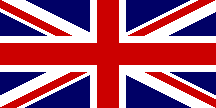
United Kingdom
|
The United Kingdom Union Jack 1801-present
The national flag of the United Kingdom combining the Cross of Saint Andrew (representing Scotland) with the Cross of Saint George (representing England) and the Cross of Saint Patrick (representing Northern Ireland), the three parts of the United Kingdom.England entered World War II after the Germans invaded Poland in September of 1939.
|
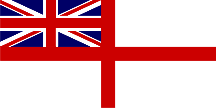
British Naval Ensign
|
The British Naval Ensign 1864-present
The White Ensign became the sole ensign of the Royal Navy in 1864. Nelson used the White Ensign at Trafalgar; it replaced the traditional Red Ensign.
|

British Red Ensign
|
British Red Ensign
Merchant ships always use the Red Ensign (a red field with the Union Jack in the canton). |
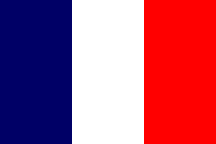
Occupied France
|
Vichy French Republic Flag 1940-1944
Since the first French Revolution the “tricolores” had been the only official French Flag. However, Northern France, including Paris, fell to Germany in the first 6 months of World War II. In the southern part of France a semi-independent French government survived by negotiating a separate peace treaty with Hilter and established their capital at Vichy, France. The Vichy government survived by supporting Nazi policies and cooperating with the invaders. After the war the supporters of this puppet government were branded traitors by the new French government.
|

Free French
|
The Free French Flag 1940-1944
The occupied part of France and those French citizens and fighters who fled the Nazi conquest, mainly to England, were known as the Free French and were led by General Charles de Gaulle. They fought on the allied side and many risked their lives as resistance fighters in France.
Vice Admiral Émile Muselier, two days after assuming the post of Chief of the Naval and Air Forces of the Free French, created this flag displaying the French colors with a red cross of Lorraine, to recall the perseverance of Joan of Arc, whose symbol it had been.
|
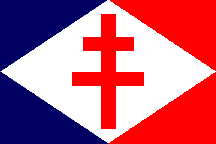
Free French Ensign
|
The Free French Honor Jack
Although this is not technically a World War II flag, this special naval jack is authorized for ships of the French Navy bearing the names of vessels which served in the Free French Navy (FNFL) during World War II. It displays a red Cross of Lorraine, the emblem of Free France, placed on a white diamond resting on a blue and red vertical striped field. I've put it here because it just seemed to fit.
|

USSR
|
The Soviet Union of Socialist Republics (USSR)
The Russians entered World War II after the Germans attacked in 1940.
The hammer and sickle represented the Russian peasants (the sickle) and the Russian workers (the hammer) who together formed the Soviet Russian state. The red field was said to represent the blood that was spilt by workers the world over in the fight for their emancipation, and was directly inherited from the red banner flown in the Paris Commune during the French Revolution. The single yellow star represented life and immense energy of the sun. The star was empty because it was said to contain the blood of the workers' struggle; and the five points of the star symbolized the then-known five continents where the revolution would spread. |
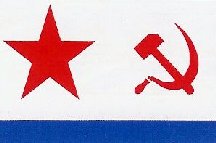
USSR Naval Ensign
|
The Union of Soviet Socialist Republics Naval Ensign 1935-1992
It was this ensign that the USSR's navy used during World War II. Soviet naval warships used this ensign between the years 1935 and 1992. With the colapse of the Soviet Union this ensign was replaced by the traditional flag of Russia (consisting of a blue "Cross of Saint Andrews" on a plain white field) first introduced in the time of Peter the Great. |
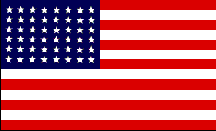
United States of America
|
The 48-Star United States Flag 1912-1959
In 1912, two stars were added to the United States flag, representing Arizona and New Mexico, bringing the total number of stars to 48. They were arranged in six rows of eight stars each. American fighting men would fight under this flag during four wars: World War I, World War II, the Korean War, and the beginning of the Vietnam War. (In 1959, a star was added for Alaska, and in 1960, a star was added for Hawaii making 50 stars today)
The United States entered World War II in 1941 after the Japanese attacked Pearl Harbor.
|
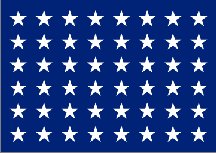
48 Star United States Jack
|
World War II United States Naval Jack
A jack is a flag that looks like the union or canton of a national flag. For ships of the United States Navy, it is a blue flag containing a star for each state. On warships, the jack is flown from a flag pole (jack-staff) located on the vessel's front end (bow) when at anchor or in port. American fighting ships would display this jack in World War I, World War II, and the Korean War. |

Australian National Flag
|
The Australian National Flag
The Australian flag is composed of three parts: The Union Jack (British flag) in the top left corner, the "Star of Federation" in the bottom left corner, and the Southern Cross, taking up the right half of the flag.
The Union Jack shows that the first colonization by Europeans was by Britain, at first as a penal colony. The Star of Federation is a seven-pointed star representing each of the six states, and having one more point for Australia's territories. The Southern Cross is a constellation that can be seen from all of Australia's states and territories. |
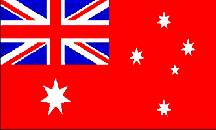
Australian Merchant Ensign
|
The Australian Merchant Ensign
The Australian Red Ensign was for all vessels registered in Australia. Initially, the Red Ensign was also the only flag private citizens could fly on land, but this was changed by the 1953 Flags Act. The Blue Ensign became the only flag private citizens could fly on land, while the use of the Red Ensign on land was prohibited. This is still true today.
|
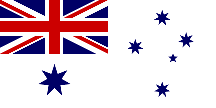
The Australian Naval Ensign
|
The Australian Naval Ensign 1967
The flag shown here was not actually adopted until 1967. Throughout World War II the Royal Australian Navy, along with their Canadian, South African, New Zealand and Indian colleagues still used the British White Ensign (shown above).
Today this White Ensign is only flown by Australian Navy warships. Private citizens and merchant ships use the Red Ensign. |
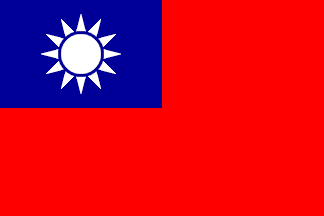
Nationalist China Flag

Nationalist Naval Jack
(originally Kuomintang Party flag)
|
The Republic of China Flag 1928
The final member of the "Big Four" of the Allies was China, a land racked with the hatred that only an ongoing and bloody Civil War can cause. The years of ruthless fighting between Mao Tse-tung's Chinese Communist Party (CCP) and Chiang Kai-shek's Kuomintang (KMT), as well as the rivalry among regional war lords had left a violent legacy as the parties battled for political control. Even so, the Chinese Nationalist government would prove to be an important ally in the war in the Pacific as they worked with the United States and their allies to defeat Japan in the Pacific. The Allied forces who served in the Chinese campaign never lost sight of their goal to assist the guerrilla forces and the Chinese government struggling to regain their country from the Japanese.
Unfortunately, although the various political factions ostensibly agreed to joined forces to fight the Japanese occupation the old hatreds were never far below the surface. As the Allied victory began to appear to become assured and distrust between the Soviet Union and the United States became more apparent, the Chinese rivalries once more resurfaced and the Civil War reignited. Eventually in 1949 the long Chinese Civil War ended, the Nationalist Chinese retreated to the Island of Taiwan declaring itself to still be the legitimate government of China and the mainland became Communist "Red China".
The Nationalist China flag had been was created in 1906 by Sun Zhongshan (Sun Yat-sen), derived from the flag of his party. When the Republic was established in 1912, the design was adopted as the naval ensign. In 1928, it was also adopted as the national flag, while its canton became the naval jack. |
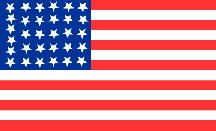
Perry's Stars and Stripes
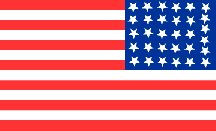
Perry's Flag as displayed
at Japanese WWII Surrender
|
Commodore Perry's Flag 1853 and 1946
In July of 1853, Commodore Matthew Perry entered Tokyo Bay with a squadron of then modern warships flying this 31-star flag to secure a treaty with Japan. His success led to formal diplomatic ties, access of ports by American ships, aid for shipwrecked American sailors, commercial trade, and the opening of Japan to other Western nations.
Ninety-two years later, at the request of Perry's cousin, General Douglas MacArthur, the flag was transported from Annapolis, Maryland, to be on hand for the surrender ceremony of the Japanese ending World War II. The 9,500-mile trip took 120 hours and covered 12 time zones. The courier, who orders required him to keep the wooden box containing the flag in his sight at all times, slept with it, ate with it, and even took it with him in the bathroom. The flag had been on display at the museum at Annapolis where conservators had mounted cotton to its mildew damaged front side to prevent the flag from breaking apart and then mounted it backward to hide the damage. The flag case was mounted on the bulkhead of the Battleship Missouri overlooking the ceremony. After its 120 hour trip, the courier slept for two days missing the 25 minute ceremony.
Notice the irregular star field, a common feature in 19th century flags when there were no design standards. In this case, they apparently just stuffed the extra star into the first column to get 31 stars and the stars are all tilted to the left. |

"VJ Day" Flag
|
Victory over Japan Flag 1945
This simple red "V" on a navy blue fielded flag was released to celebrate the victory over Japan in 1945, but its manuafacture actually dates back to 1944. Today in the United States the name "VJ Day" (Victory over Japan) is celebrated on August 15, because of a huge two-day worldwide celebration that took place after the Empire of Japan announced it was surrendering in August - thus ending the fighting in World War II. The holiday is also referred to as "Victory in the Pacific," or VP Day, in Australia where it is celebrated each August 16. However, the official formal surrender didn't take place until September 2 in Tokyo Bay. This happened aboard the USS Missouri when the actual surrender papers were signed.
On the hoist line of this flag it stated that it was made at Mare Island in 1944. Retired Chief Walter Dougherty (QMC), explained that the flag was approved by President Roosevelt, and distributed in 1944 to be flown by all Navy units and bases on the day Japan surrendered. GMC Ret. David "Tim" Lake, a World War II vet, served on the Battleship Pennsylvania (BB-38) from 1941 through 1946. Chief Lake remembers this flag being flown when the ship returned to the states after the war. The "Pennsy" was flagship of the Pacific Fleet for much of the war. |
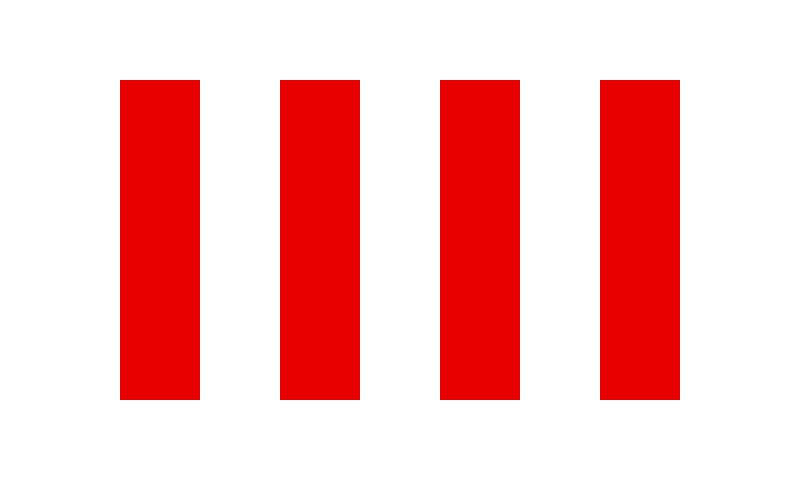
"Four Freedoms" Flag
|
United Nations Honor Flag 1943-1948
The "Four Freedoms flag" or "United Nations Honor Flag," was influenced by Roosevelt's Four Freedoms speech, and intended to symbolize the World War II Allies and their goals, as set down in the Atlantic Charter and the Declaration by United Nations. This flag was designed by Brooks Harding in October 1942, and saw some use between 1943 and 1948.
It has sometimes been called the first "United Nations flag," but was never an official organizational flag of the United Nations. |
| Top of Page | Between Wars | Flags of the Axis Powers | Flags of the Allies |
|